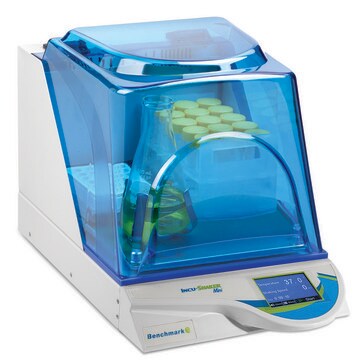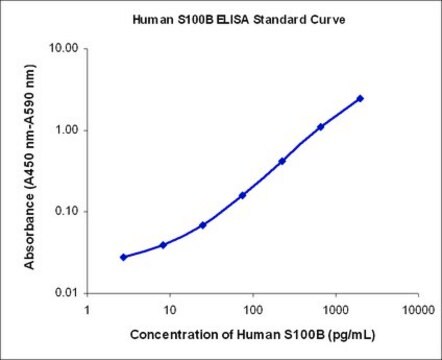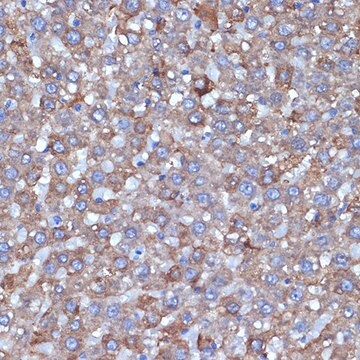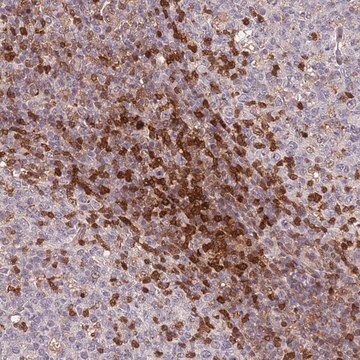一般說明
We are committed to bringing you greener alternative products, which adhere to one or more of The 12 Principles of Green Chemistry.This antibody is Preservative-free, produced without the harm or sacrifice of animals and exceptionally stable to allow for ambient shipping and storage if needed and thus aligns with "Waste Prevention", "Designing Safer Chemicals" and "Design for Energy Efficiency".
Click here for more information.
ZooMAb® antibodies represent an entirely new generation of recombinant monoclonal antibodies.Each ZooMAb® antibody is manufactured using our proprietary recombinant expression system, purified to homogeneity, and precisely dispensed to produce robust and highly reproducible lot-to-lot consistency. Only top-performing clones are released for use by researchers. Each antibody is validated for high specificity and affinity across multiple applications, including its most commonly used application. ZooMAb® antibodies are reliably available and ready to ship when you need them.
特異性
Clone N103/39 is a ZooMAb® Mouse recombinant monoclonal antibody that specifically detects Aldehyde dehydrogenase family 1 member L1 (Aldh1L1).
免疫原
Full-length recombinant rat Aldehyde dehydrogenase family 1 member L1 (Aldh1L1).
應用
Quality Control Testing
Evaluated by Western Blotting in Rat Brain tissue lysate.
Western Blotting Analysis: A 1:1,000 dilution of this antibody detected Aldh1L1 in Rat Brain tissue lysate.
Tested applications
Western Blotting Analysis: A 1:1,000 dilution from a representative lot detected Aldh1L1 in human and mouse brain tissue lysates.
Immunohistochemistry (Paraffin) Analysis: A 1:100 dilution from a representative lot detected Aldh1L1 in human brain and rat brain tissue sections.
Immunofluorescence Analysis: A 1:100 dilution from a representative lot detected Aldh1L1 in human cerebral cortex tissue sections.
Note: Actual optimal working dilutions must be determined by end user as specimens, and experimental conditions may vary with the end user
標靶描述
Cytosolic 10-formyltetrahydrofolate dehydrogenase (UniProt: P28037; also known as EC:1.5.1.6, 10-FTHFDH, FDH, Aldehyde dehydrogenase family 1 member L1, FBP-CI) is encoded by the Aldh1I1 (also known as Fthfd) gene (Gene ID: 64392) in rat. Aldh1L1 is a multidomain cytoplasmic protein that serves as pan-astrocyte marker. It is expressed almost exclusively in astrocytes but not in other neural cells. Its expression has been reported in most GFAP+ astrocytes. It is more homogeneously expressed in astrocytes throughout the brain than GFAP, the classical astrocyte marker. It has two functionally unrelated domains, a C-terminal aldehyde dehydrogenase-homologous domain and a folate-binding hydrolase domain. These two domains are thought to be connected by a 100-residue linker. Aldh1L1 catalyzes the conversion of 10-formyltetrahydrofolate, nicotinamide adenine dinucleotide phosphate (NADP+), and water to tetrahydrofolate, NADPH, and carbon dioxide. Asp142 is shown to be an essential residue in the enzyme mechanism for both the hydrolase and dehydrogenase reactions indicating that either the two catalytic centers of Aldh1L1 are overlapped or the dehydrogenase reaction occurs within the hydrolase catalytic center. Cys707 is shown to be directly involved in its active site and is responsible for dehydrogenase activity. Loss of function or expression of Aldh1l1 gene has been linked to reduced apoptosis, increased cell motility, and cancer progression. This ZooMAbZooMAb® recombinant monoclonal antibody, generated by our propriety technology, offers significantly enhanced specificity, affinity, reproducibility, and stability over conventional monoclonals. (Ref.: Beyer, F., et al. (2021). Front. Neurosci. 15; 713077; Krupenko, SA., and Wagner, C. (1999). J. Biol. Chem. 274(50); 35777-35784; Krupenko, SA., et al. (1995). J. Biol. Chem. 270(2); 519-522).
外觀
Purified recombinant mouse monoclonal antibody IgG, lyophilized in PBS with 5% Trehalose, normal appearance a coarse or translucent resin. The PBS/trehalose components in the ZooMAb formulation can have the appearance of a semi-solid (bead like gel) after lyophilization. This is a normal phenomenon. Please follow the recommended reconstitution procedure in the data sheet to dissolve the semi-solid, bead-like, gel-appearing material. The resulting antibody solution is completely stable and functional as proven by full functional testing. Contains no biocide or preservatives, such as azide, or any animal by-products. Larger pack sizes provided as multiples of 25 μL.
重構
300 μg/mL after reconstitution at 25 μL per vial. Please refer to guidance on suggested starting dilutions and/or titers per application and sample type.
儲存和穩定性
Recommend storage of lyophilized product at 2-8°C; Before reconstitution, micro-centrifuge vials briefly to spin down material to bottom of the vial; Reconstitute each vial by adding 25 μL of filtered lab grade water or PBS; Reconstituted antibodies can be stored at 2-8°C, or -20°C for long term storage. Avoid repeated freeze-thaws.
法律資訊
ZooMAb is a registered trademark of Merck KGaA, Darmstadt, Germany
免責聲明
Unless otherwise stated in our catalog or other company documentation accompanying the product(s), our products are intended for research use only and are not to be used for any other purpose, which includes but is not limited to, unauthorized commercial uses, in vitro diagnostic uses, ex vivo or in vivo therapeutic uses or any type of consumption or application to humans or animals.










